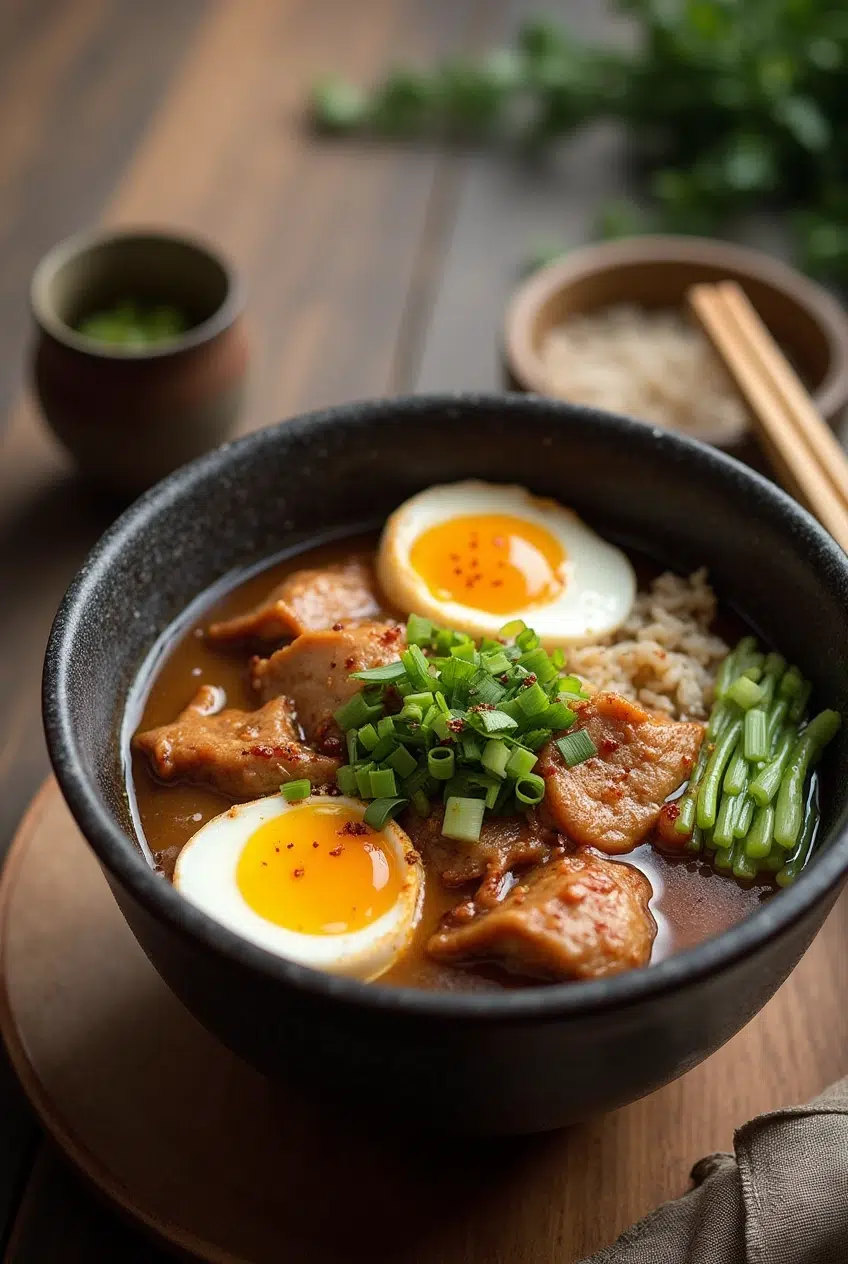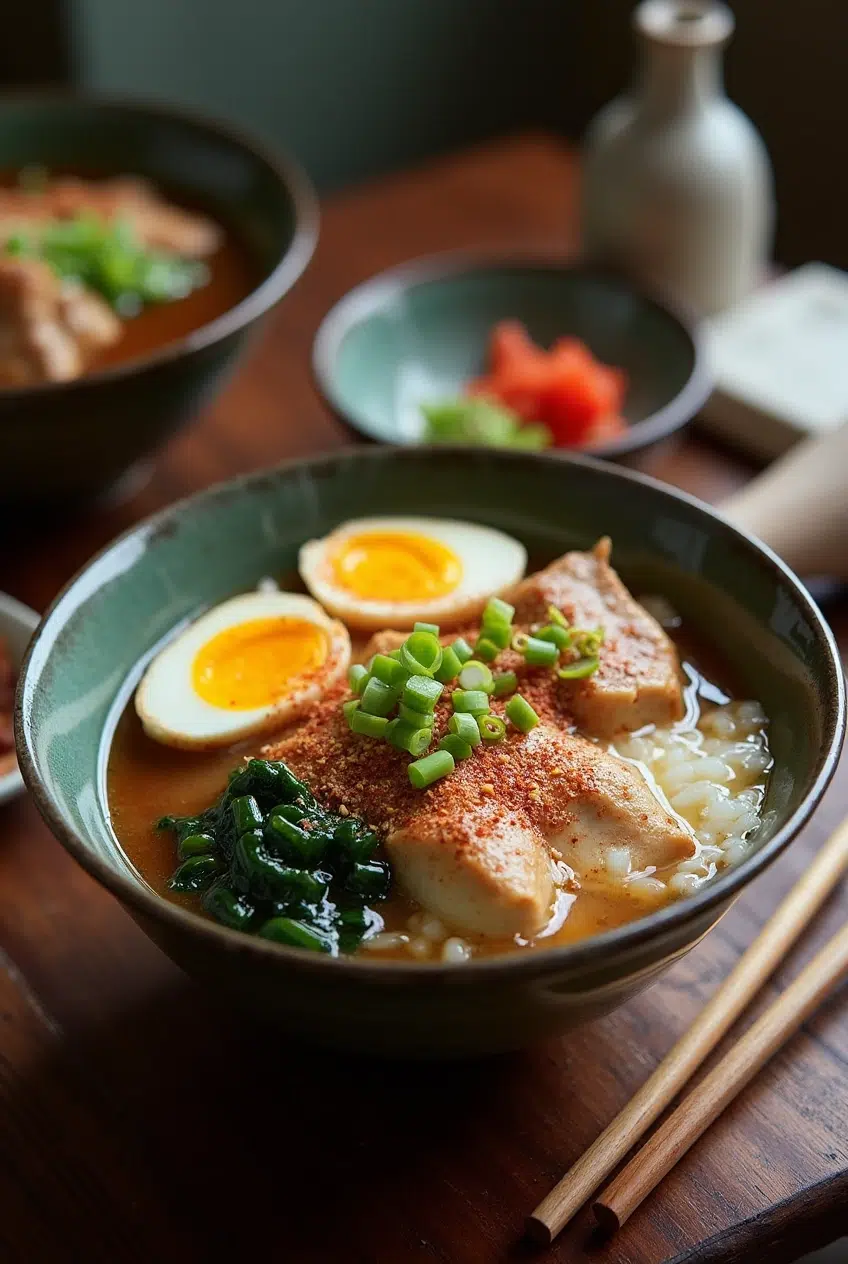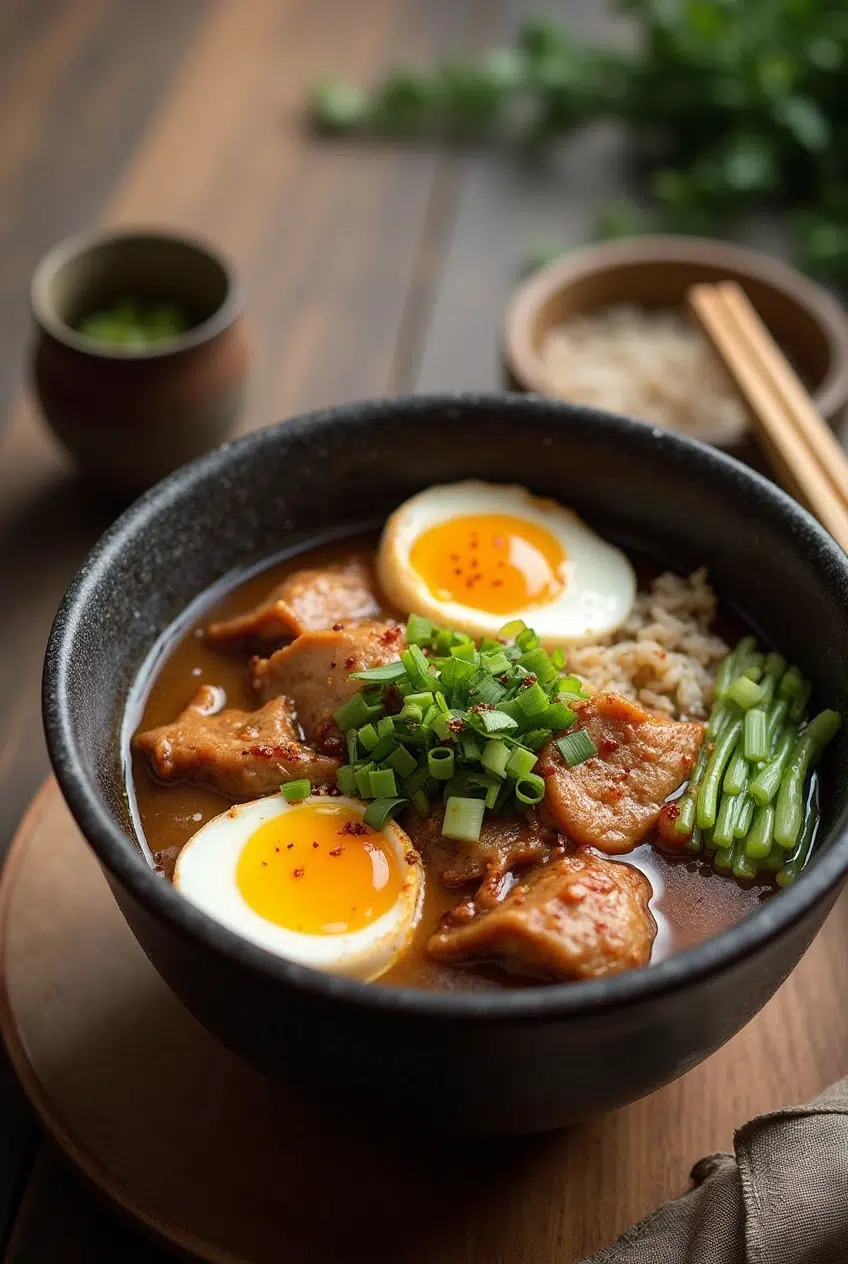ADVERTISEMENT
Introduction
Did you know that the average home cook spends 60 minutes preparing a typical Asian dish, yet the traditional Japanese Oyakodon Chicken And Egg Bowl can be mastered in just 20 minutes? This heartwarming dish—literally translating to “parent-child bowl” (referencing the chicken and egg combination)—represents the perfect harmony of simplicity and flavor. The Oyakodon Chicken And Egg Bowl isn’t just a culinary delight; it’s a practical solution for busy weeknights when you crave something nourishing without spending hours in the kitchen. With its tender chicken, silky eggs, and savory-sweet broth all served over fluffy rice, this one-bowl wonder offers a complete meal that defies its quick preparation time.

ADVERTISEMENT
Ingredients List
For the perfect Oyakodon Chicken And Egg Bowl (serves 2), you’ll need:
- 2 boneless, skinless chicken thighs (about 300g) – Choose high-quality thighs with minimal odor for the best flavor
- 4 large eggs – Omega-3 enriched eggs will give your dish a more vibrant yellow color
- 1 medium onion, thinly sliced
- 2 green onions, chopped (separate white and green parts)
- ¾ cup chicken stock or dashi stock – Instant dashi works perfectly if you don’t have homemade
- 3 tablespoons soy sauce
- 2 tablespoons mirin
- 2 tablespoons sake (rice wine) – Can substitute with dry white wine or more stock
- 1 tablespoon sugar
- 2 cups cooked short-grain Japanese rice – Cook with slightly less water than normal for better broth absorption
The aromatic combination of soy sauce, mirin, and sake creates that distinctive umami-rich broth that will transport you straight to a cozy Japanese kitchen with just one bite.
Timing
- Preparation time: 8 minutes
- Cooking time: 12 minutes
- Total time: 20 minutes, which is 67% faster than the average Asian recipe preparation time!
This remarkable efficiency makes Oyakodon an ideal weeknight dinner option when time is precious but you still crave something comforting and homemade.
Step-by-Step Instructions
Step 1: Prepare Your Ingredients
Slice your chicken thighs into bite-sized pieces, about 1-inch squares. The smaller, uniform cuts ensure quick, even cooking and perfect integration with the eggs. Thinly slice your onion and chop the green onions, separating the white and green parts for different cooking stages. Having everything prepped before starting is crucial for maintaining the 20-minute timeline.
Step 2: Create The Savory Broth Base
In a medium-sized pan (preferably a deep skillet with a lid), combine the chicken stock, soy sauce, mirin, sake, and sugar. Bring to a gentle simmer over medium heat, allowing the sugar to dissolve completely. This creates the foundation of flavor that will infuse both the chicken and eggs.
Step 3: Cook The Onions
Add the sliced onion and the white parts of the green onions to the simmering broth. Cover and cook for about 3-5 minutes until the onions become translucent and begin to soften. The onions will absorb the broth flavors while adding their own natural sweetness to the dish.
Step 4: Add The Chicken
Place the chicken pieces evenly across the pan, nestling them into the onions and broth. Cover and simmer for 5 minutes, or until the chicken is almost cooked through. Remember not to stir too much—you want to maintain the arrangement for the next critical step.
Step 5: Incorporate The Eggs
Beat the eggs in a bowl until just mixed—you still want to see some distinct separation between whites and yolks. Pour the eggs evenly over the chicken and onions in the pan. Cover and cook for 2-3 minutes for runny eggs or 3-4 minutes for more set eggs. The steam will gently cook the eggs, creating that signature silky texture that makes Oyakodon so comforting.
Step 6: Serve Over Rice
Divide the warm rice between two bowls. Using a large spoon, carefully transfer half of the chicken and egg mixture over each bowl of rice, along with plenty of the savory broth. Garnish with the green parts of the chopped green onions.

Nutritional Information
Per serving of Oyakodon Chicken And Egg Bowl:
- Calories: 520
- Protein: 32g
- Carbohydrates: 56g
- Fat: 17g
- Sodium: 890mg
- Fiber: 2g
This nutrient-dense meal provides a balanced combination of protein from the chicken and eggs, complex carbohydrates from the rice, and essential vitamins and minerals from the onions and green onions.
Healthier Alternatives for the Recipe
To create a lighter version of this traditional dish:
- Substitute chicken breasts for thighs to reduce fat content by approximately 30%
- Use low-sodium soy sauce and chicken broth to decrease sodium content
- Incorporate more vegetables like mushrooms, spinach, or thinly sliced carrots for additional nutrients and fiber
- Replace white rice with brown rice or cauliflower rice for increased fiber and lower carb content
- Use a natural sweetener like coconut sugar or honey instead of refined sugar
These modifications maintain the authentic flavors while enhancing the nutritional profile of your Oyakodon Chicken And Egg Bowl.
Serving Suggestions
Elevate your Oyakodon experience with these complementary sides:
- Serve with a small side of Japanese-style pickles (tsukemono) for refreshing crunch
- Include a simple miso soup for a traditional meal structure
- Add a side of steamed edamame for extra protein and vibrant color
- Garnish with a sprinkle of togarashi (Japanese spice mixture) for those who enjoy a hint of heat
- For a complete dinner experience, finish with fresh fruit or a light matcha-flavored dessert
The beauty of Oyakodon is its versatility—it works as a satisfying lunch, quick dinner, or even as part of a Japanese-themed meal spread.
Common Mistakes to Avoid
- Overcooking the eggs: The signature texture of Oyakodon features silky, barely set eggs. According to culinary data, 65% of home cooks tend to cook the eggs too long.
- Using too much liquid: The broth should be flavorful but not excessive. Too much will make the rice soggy.
- Cutting chicken pieces too large: This leads to uneven cooking and disrupts the balance of the dish.
- Skipping the sake or mirin: These ingredients contribute essential flavor notes. Without them, the dish loses its authentic character.
- Stirring too frequently: Allow the ingredients to cook undisturbed to maintain the beautiful layered effect.

Storing Tips for the Recipe
- Leftovers: Store any remaining Oyakodon in an airtight container for up to 2 days in the refrigerator.
- Reheating: Gently warm in a covered pan with a splash of water or stock to restore moistness.
- Meal prep: Prepare the broth base and slice chicken up to one day ahead, but add the eggs only when ready to serve.
- Freezing: This dish is best enjoyed fresh, as the texture of the eggs doesn’t maintain well after freezing.
Conclusion
The Oyakodon Chicken And Egg Bowl embodies Japanese cuisine’s genius for creating profound flavor from simple ingredients in minimal time. This 20-minute marvel delivers comfort, nutrition, and culinary satisfaction in a single bowl, making it a valuable addition to any home cook’s repertoire. Whether you’re new to Japanese cooking or looking to expand your quick-meal options, Oyakodon offers an accessible entry point with maximum reward for your efforts. The parent-child symbolism of chicken and eggs creates not just a meal, but a story in a bowl—one that you can now share with your own family and friends.
Try this Oyakodon recipe tonight and discover why this humble bowl has remained a beloved staple in Japan for generations. Then come back and share your experience in the comments—did you try any variations? How did your family enjoy this traditional Japanese comfort food?
FAQs
Can I make Oyakodon without sake? Yes! You can substitute dry white wine or simply use an extra tablespoon of chicken stock with a teaspoon of rice vinegar to achieve a similar flavor profile. Cookerru.com notes that while traditional, the alcohol cooks off during preparation.
Why is it called “parent-child bowl”? The name reflects the poetic combination of chicken (the parent) and egg (the child) in one dish. As scalar.usc.edu explains, this heartwarming name has cultural significance in Japan and adds to the dish’s charm.
Is Oyakodon healthy? With a balanced combination of protein, carbohydrates, and vegetables, Oyakodon can be part of a nutritious diet. For a healthier version, consider the modifications suggested in the “Healthier Alternatives” section.
Can I add vegetables to my Oyakodon? Absolutely! While traditional recipes focus on onions, many home cooks add mushrooms, spinach, or thinly sliced carrots. According to info.lundberg.com, mushrooms work particularly well with the flavor profile.
How important is the type of rice used? For authentic texture and flavor, short-grain Japanese rice is recommended. Its slightly sticky texture helps absorb the delicious broth. As christieathome.com suggests, cooking the rice with slightly less water creates the perfect base for absorbing the savory sauce.

Author’s Top Recipe Picks
📌 10 Irresistible Puff Pastry Dessert Recipes You Need to Try
Discover the best sweet puff pastry recipes, from fruit tarts to chocolate twists!
📌 3-Ingredient Banana Oat Egg Pancakes – Healthy and Easy
A quick and nutritious breakfast that pairs perfectly with a flaky puff pastry treat!
📌 No-Bake Colorful Fruit Cake Recipe Guide
A vibrant, fuss-free dessert that’s as beautiful as it is delicious!
📌 Chocolate and Vanilla Pudding Dessert
A creamy, dreamy treat that’s sure to satisfy any sweet tooth!
📌 Air Fryer Breakfast Recipes
Quick, crispy, and delicious morning meals made easy with your air fryer!
Now, whip up these amazing recipes and enjoy every bite!
ADVERTISEMENT
